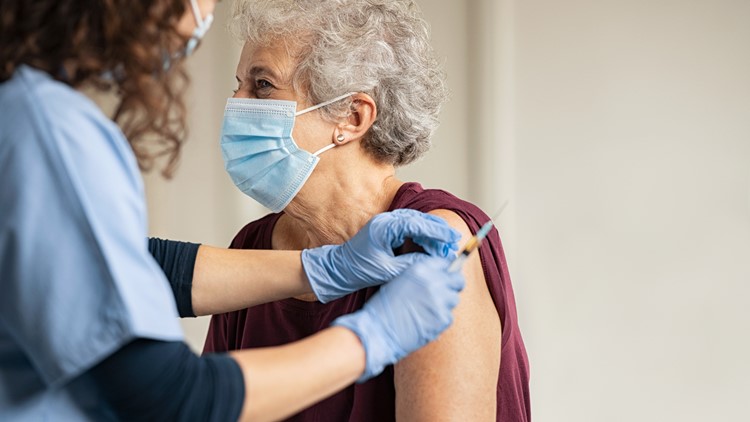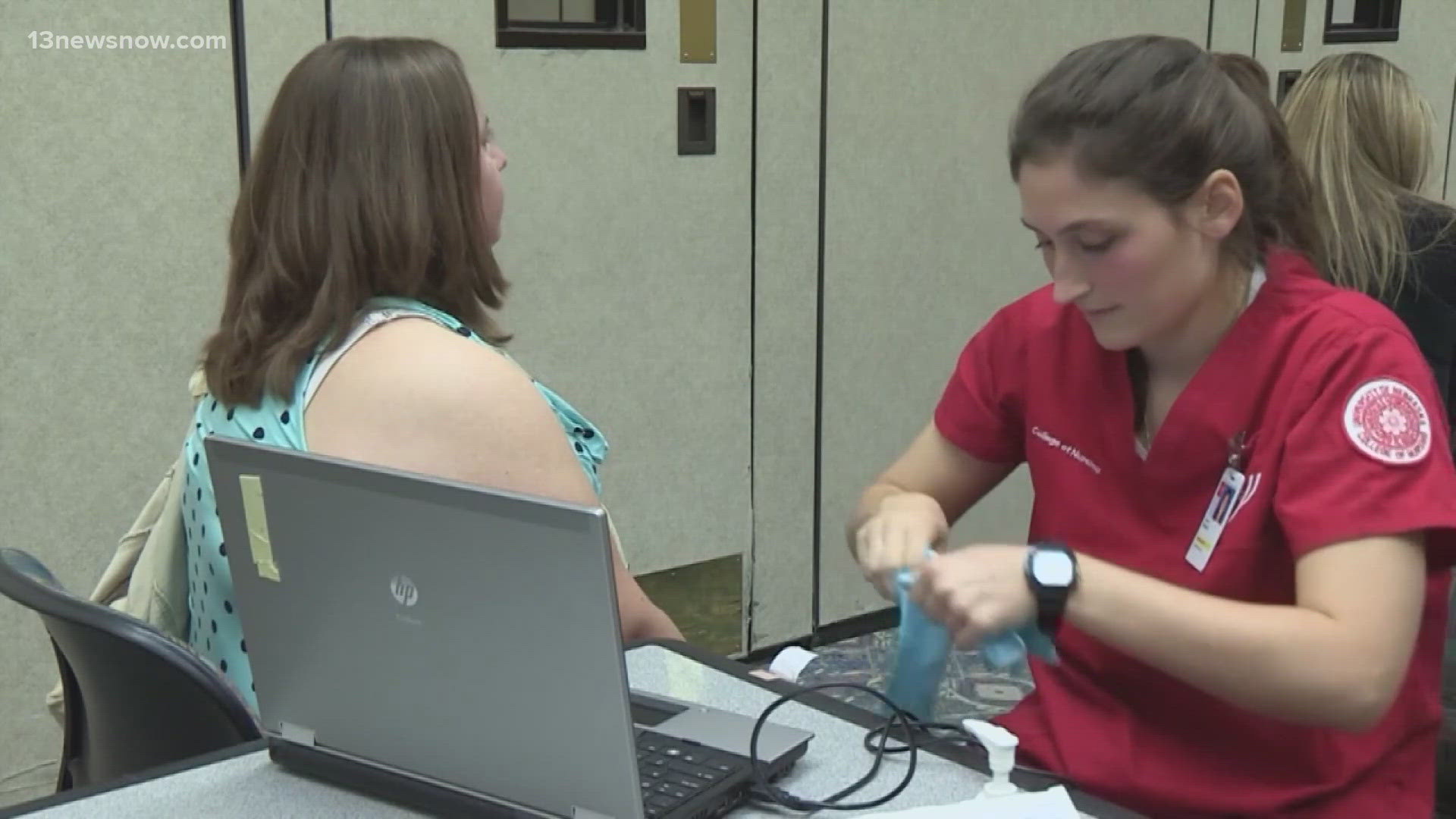HARRISONBURG, Va. — Like many kids his age, James Hartt as a teen in the '60s enjoyed passing the time with a bit of naive, reckless abandonment. One way Hartt found to amuse himself was leaping from a nearby bridge and sticking the landing on the other side, until one day, Hartt woke up unable to move his legs. Immediately, fear set in that it could be poliomyelitis — every parent's waking fear in the late 1940s and early 1950s.
Fortunately, a doctor deduced Hartt's diagnosis was two sprained legs as a result of his airborne adventures, but many children around the world were not as fortunate. When it became available, Hartt got his vaccine. Nearly 70 years later, Hartt senses a stark parallel to the excitement he felt then as he prepares to receive his second COVID-19 vaccine this weekend.
"If you look back, polio and this thing is almost the same type of thing," Hartt said. "Polio, they used iron lungs back then. Now they're using … those air things that they run out of all the time. The symptoms are very close. The way they treated it was very close."
Poliomyelitis — better known as polio — is an infectious disease that most commonly affects children, causing paralysis. Summer of 1894, the U.S. experienced its first polio epidemic, but it wasn't until 1955 that Dr. Jonas Salk's polio vaccine was approved for nationwide inoculation. Shortly after, a second vaccine option was approved for manufacturing with easier admission at a cheaper cost by Dr. Albert Bruce Sabin in 1961.
After cases peaked in 1952, with roughly 58,000 people diagnosed with polio in the U.S., the final case of wild-virus polio in the U.S. was reported in 1979.
With a tight-fisted grip around the nation, polio impacted thousands of children annually into the late 1950s, mercilessly attacking the nervous system. It was typically identified by paralyzed limbs, most frequently the legs. By 1957, there were less than 6,000 cases, and it had dropped to 120 cases by 1964, thanks to vaccines.
Today's pandemic of the novel coronavirus is harder to identify physically and largely plagues the lungs, which can lead to pneumonia, respiratory failure, septic shock or death, in severe cases.
Now those same children who were most vulnerable to the polio epidemic are grown and at greater risk for severe illness from COVID-19, but the fastest vaccine ever created is steadily being distributed in phases following the authorization of Pfizer's vaccine on Dec. 12 and Moderna's version six days later.
According to the Centers for Disease Control and Prevention, two doses of Salk's polio vaccine are 90% effective or more and three doses boost the effectiveness to 99-100%. Both Pfizer and Moderna report their vaccines show approximately 95% efficacy at preventing both mild and severe symptoms of COVID-19.
"I believe in these shots, and I believe they're doing the best thing they can," Hartt said.
According to the March of Dimes, the leading global agency fighting polio, up to 95% of people infected with polio were asymptomatic and less than 1% of infected persons experienced the virus attacking their nervous systems within the spine to result in partial or complete paralysis.
Salem-based Rotarian William "Bill" Long is locally known as a polio expert. His father-in-law contracted polio in his youth, which stunted the growth of one leg. The connection inspired Long, who owns three iron lungs — a clunking beast of machinery that contracted lungs for those who could not breathe on their own — to allow the machinery to travel between Rotary clubs for educational purposes.
Long said the demand for hospital care was overwhelming, much like today's limitation of ventilators, and Memorial and Crippled Children's Hospital in Roanoke was the primary care facility for sick children in the southern Valley.
"A whole floor with nothing but iron lungs on it," he said. "Space between each iron lungs, just wide enough for people to get through to work."
In the Jan. 25, 1946, edition of James Madison University's newspaper, The Breeze, W. L. Baldwin, state chairman for the polio fundraiser, is quoted as saying, "It is believed that over the last two-year period, Virginia has been hit harder by poliomyelitis than any other state in the nation."
Following data reports Virginia's county and city goals that year were set more than 25% higher due to the cost of caring for over 1,100 polio victims over the span of 19 months. Infantile paralysis struck down children of every income bracket in 94 of the 100 counties of Virginia over the previous two years.
According to the CDC, there are 27 million total cases of COVID-19 in the U.S. and 486,466 total deaths, as of Wednesday.
Belmont resident Nancy O'Hare is scheduled to receive her second vaccine by the end of February, and she vividly remembers the fear that haunted her days and nights mothering a 5-year-old son and 2-year-old daughter while polio raged on.
"I remember when Salk developed the vaccine. I remember when my children, who are now in their 60s, got the vaccine. … It took them years to develop the one to defeat polio, so I'm thrilled we're able to do it so quickly now, develop this vaccine," O'Hare said.
Back then, O'Hare remembers going to doctor's offices to receive the polio vaccine while children received sugar cubes topped with Sabin's oral vaccine from schools or pediatrician offices.
"We did not go to hospital, we did not go to vaccination stations. … When it was released to be able to be consumed, it was fast. It was all over the country," she said.
Verona native Donn Meyer said he can remember his parents taking him to Fort Defiance High School at a very young age to receive the polio vaccine on a sugar cube in the '60s.
Back then, images of iron lungs were plastered on every screen, and harrowing stories of sick children written in papers. A nationwide vaccine campaign even featured Elvis Presley publicly receiving his vaccination.
"We'd seen the pictures, we'd heard TV reports, we'd seen movies about it. And it was scary and that's why I think the world was so happy, or at least the United States was so happy, when the polio vaccine came out," O'Hare said.
An archived Associated Press article published in Daily News-Record on Aug. 13, 1955, reported that Southern states pioneered public programs to distribute the Salk vaccine shots to schoolchildren and tentative survey results showed a 46% drop in polio deaths compared to the previous year. By the time of publication, 191 deaths were recorded, compared to 355 within the same time the previous year.
While polio seems a thing of the past within the U.S., there is no cure for the disease and two countries remain endemic. Rotary International remains a leading agency in funding the end of polio, and members have contributed more than $2.1 billion to eliminate the paralyzing disease since 1979.
With polio a shadow of a memory for most Americans today, those who endured the polio epidemic remember the clear parallels of quarantines, school closures and the dread.
"Same things happened," Hartt said. "I think they've come across something that's going to work, and I think everyone should get it."



